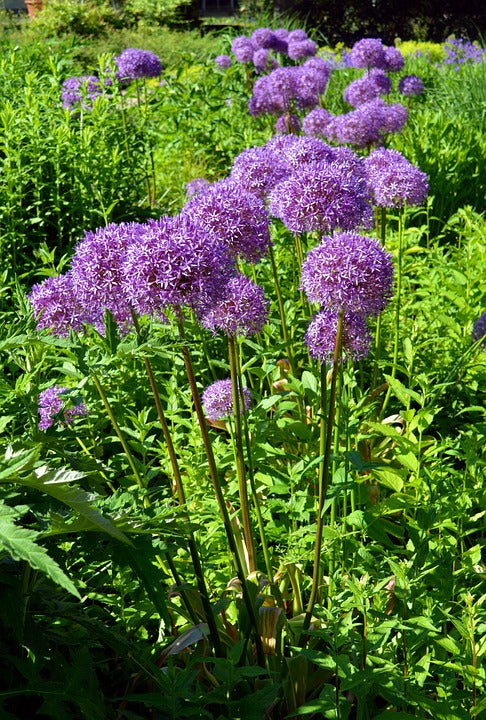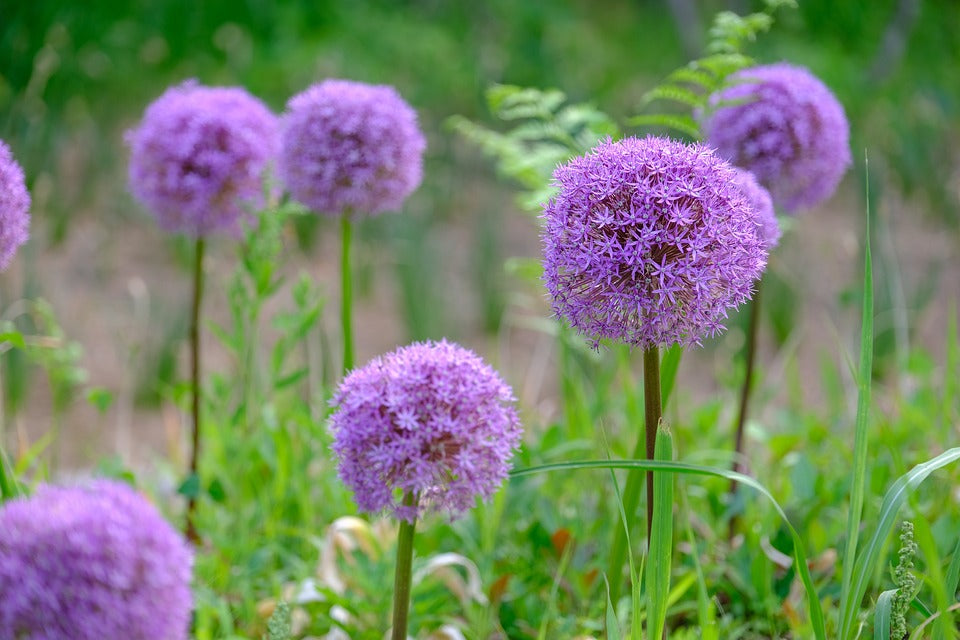
At a recent meeting of our local garden club, a fellow member introduced us to a plant that we frankly find delightful. Giant allium—also know as giant onion, ornamental onion, or Allium giganteum—is the largest member of the allium or onion family and produces striking, whimsical blooms in early/mid summer. With its impressive height and purple poof-ball blooms, giant allium caught our attention and our imagination immediately. We asked a lot of questions, bought some plants to take home, and decided to write a blog about this new gardening feature. Growing giant allium can add a fun twist to any garden, so let’s dig in!
What is Giant Allium?
As we’ve mentioned and as the name indicates, giant allium is a member of the allium family, which also includes onions, garlic, shallots, leeks, and chives. A native of southwest Asia, giant allium is found in the wild across Turkey, Turkmenistan, Iran, Afghanistan, and parts of Uzbekistan. In the wild, it likes disturbed ground, and may become weedy if left to its own devices. Giant allium is a relatively hardy plant, able to thrive in USDA zones 6-10, making it a flexible feature in many gardens. In addition, its large clusters of blooms attract and support pollinators like bees, which may make Allium giganteum the perfect addition to your bee-friendly garden.

Is Giant Allium (Allium giganteum) Edible?
While all alliums are edible, as far as we know, giant allium is a bit problematic. Frankly, it doesn’t taste all that great, per most people who have tried it. It contains high levels of sulfides, which give it a bitter flavor and may cause nausea, vomiting, and diarrhea in many people. Thus giant allium is best regarded as an ornamental rather than an edible plant, despite having many edible relatives.
Pet safety note: giant allium is toxic to dogs and cats if ingested, so please be careful!

Planting and Growing Giant Allium
Giant allium, like many members of its family, is fairly easy to grow. Like many alliums, it prefers either a sandy or light loamy soil with good drainage. While giant allium tolerates dry periods and even drought, it does best when kept moist—but not too moist. Overly-wet soil can lead to root rot and other problems, so keep an eye on your soil conditions and moisture levels. Giant alliums are generally pest-free in most areas, making them an easy plant to care for.
The ideal spacing for giant allium is one plant per square foot, so be mindful if you’re starting from bulbs rather than plants. They can be grown in large containers, as long as they get the right soil mix and good water, making them a fun experiment for patio gardeners. As a landscaping feature, they do well among low-lying grasses or flowering plants or shallow—rooting flowers like snowdrops, crocus, or grape hyacinth. They do die off after blooming, so also consider planting foxglove, coreopsis, or red hot pokers around giant allium for successive flowering that disguises dry stems. And giant allium can look lovely against a backdrop of azaleas, hydrangeas, or ornamental vines.

There’s a lot more to be said about this plant, and we’re learning more as we grow it in our own gardens. If you have experience with giant allium, get in touch and let us know!

Leave a comment